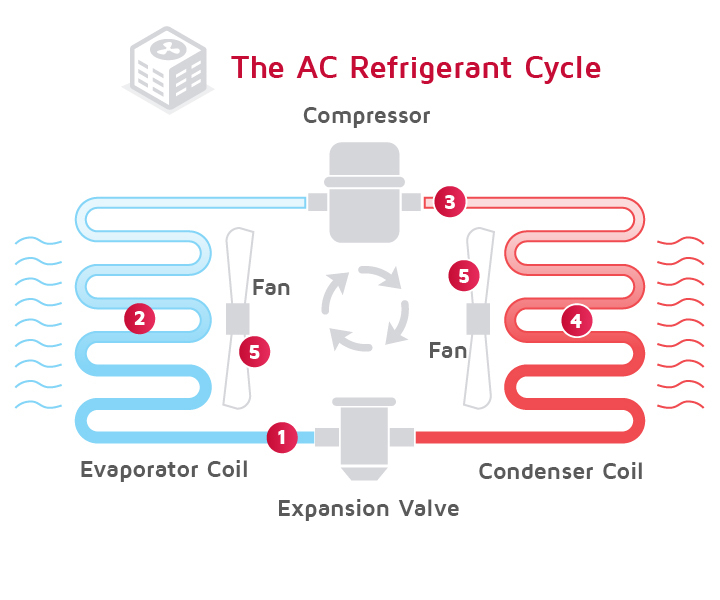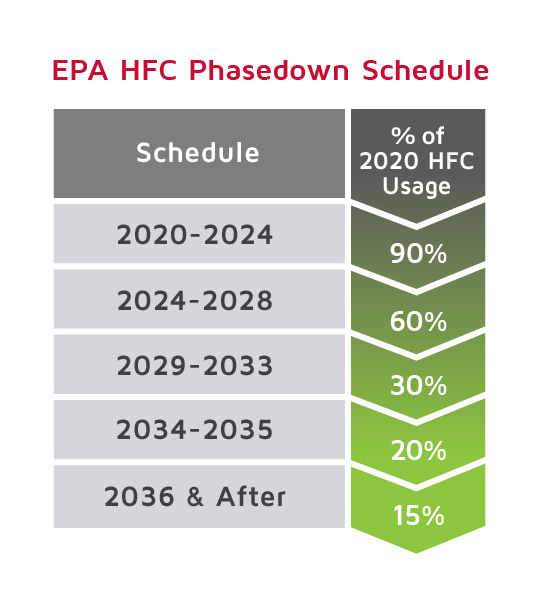What is Refrigerant?
Refrigerant is the working fluid used in air conditioners, refrigeration, and heat pump systems. It is a chemical compound that changes temperature as it transitions between liquid and gas form – cooling as it vaporizes, and heating up as it condenses. It is this property that facilitated a system’s ability to heat and cool.
Though a necessary component of all residential or commercial cooling system today, refrigerants are heavily regulated by the government. Early refrigerants were often toxic and flammable, and if released, caused serious damage to the atmosphere. Though most of those dangers have been reduced or eliminated, modern compounds still pose a risk to the environment – contribution to climate change and ozone depletion. Since the 1980s, increased standards and restrictions have driven efficiency and technology toward safer, more environmentally friendly refrigerant solutions.
The Importance of Refrigerant in HVAC Systems and How it Works
Refrigerant is the key ingredient in any air conditioner or heat pump. It’s what enables the system to affect the temperature of a home. Liquid refrigerant lives in the coils of an AC or heat pump unit. Condensers and evaporators connected to your thermostat act on those coils to compress or vaporize the refrigerant inside, producing temperature changes within the coils. The system’s fan then blows air over the coils, distributing the temperature-adjusted air throughout your home.
As air conditioners specifically generate cool air, they only make use of the evaporation cycle of this process. Heat pump systems on the other hand, take advantage of both sides of the cycle – using the heat generated by the condensation process to generate warm air.
Here is how the refrigerant cycle works within a typical AC unit:

- The expansion valve relieves pressure and passes the refrigerant into the evaporator coil as a cold, low-pressure liquid.
- As the refrigerant warms within the coil, it phases back into a gaseous state.
- The cool gas is compressed and fed into the condenser coil as a hot, high-pressure gas.
- As the hot, pressurized refrigerant cools within the condenser coil, it phases back into a warm liquid state.
- This process triggers the air handler within your system to distribute the heated or cooled air throughout your home based on your thermostat settings.
Refrigerant Types and Their Differences
Though there have been several types of refrigerants in service since commercial production began in 1931, there are only a few types legally usable under present day regulations. Lennox uses (or has used) the following 3 types:
R-22
R-22 (freon) is the old standard for residential air conditioners. In 2020 the decision to stop production of R-22 was made by the U.S. Environmental Protection Agency. Though production will cease, recovered, recycled, or reclaimed supplies of R-22 will still be available for the continued servicing of existing systems.
The production of R-22 compatible equipment will also stop, but there is no requirement to upgrade existing R-22 systems. In the future, as R-22 supplies become more limited, the cost of servicing that equipment is expected to rise.
R-410A
R-410A, the current standard for residential air conditioners and heat pumps was originally developed as a more environmentally friendly alternative to R-22. It was adopted as a replacement for R-22 primarily because it poses zero risk to the ozone. However, based on the latest EPA standards which also take into account global warming effects, R-410A is set to be phased out under similar conditions as R-22.
R-454B
Far safer for the environment, R-454B is set to be the new standard in residential refrigerants. It has a 78% lower Global Warming Potential (GWP) when compared to R-410A and zero Ozone Depletion Potential (ODP). R-454B is currently being phased in as compatible equipment and upgrades replace older models.
Lennox has chosen R-454B as its 2025 Compliant Refrigerant.
The History – and Future of Refrigerants
In the early years of refrigeration technology, the majority of refrigerants in use were flammable, toxic, or both. Some were even volatile enough to cause explosions or dangerous gas leaks when used in improperly maintained equipment. This prompted the government, in 1926 to task Dr. Thomas Midgley to develop an efficient, non-flammable refrigerant that could be put into commercial use.
Based on their work, R-12, the first reasonably stable chlorofluorocarbon (CFC) refrigerant was synthesized in 1928.
The development of fluorocarbon refrigerants was announced around 1930. That year, at a meeting of the American Chemical Society, Dr. Midgley demonstrated the safety of the new compound by dramatically inhaling it and then using it to blow out a candle. Commercial production of R-12 began in 1931.
Here are a few other key points in the history of refrigerant development:
1936 R-22, the first hydrochlorofluorocarbon (HCFC) refrigerant, was produced.
1950s R-22 became the most common refrigerant in residential air conditioners.
1987 The Montreal Protocol Treaty is signed by 197 countries. This began the phase-out and consumption of ozone-depleting substances (ODS) – which included R-22.
1990s R-410A, a hydrofluorocarbon compound (HFC), became the new standard refrigerant in residential air conditioning and heat pumps.
2020 The American Innovation and Manufacturing (AIM) Act is passed.
As a part of a global agreement to reduce greenhouse gasses, the American Innovation and Manufacturing (AIM) Act gave the US Environmental Protection Agency (EPA) authority to address the effects of hydrofluorocarbons (HFCs) by beginning the phase-down of refrigerants with high Global Warming Potential (GWP) before 2036.

In the early 1980s it was discovered that hydrochlorofluorocarbons (HCFCs), the primary type of refrigerant compounds in use at the time, were causing major damage to the ozone layer – the atmospheric layer that protects the Earth from the Sun’s UV radiation. This compelled governments across the world to band together to identify safer refrigerants and better regulate those in use – eventually resulting in the development of R-410A, the first modern hydrofluorocarbon (HFC) refrigerant. IMAGE 3
Since then, the EPA and the world have worked to develop newer, more environmentally friendly refrigerants, R-454B being the latest. The  U.S. along with many other nations have instituting agreements and adopted phasedown schedules that will help to draw down the accumulation of refrigerant-produced greenhouse gasses in the atmosphere and reduce the risk of global warming by fully converting to R-454B by 2034.
U.S. along with many other nations have instituting agreements and adopted phasedown schedules that will help to draw down the accumulation of refrigerant-produced greenhouse gasses in the atmosphere and reduce the risk of global warming by fully converting to R-454B by 2034.
Refrigerant safety and handling
Because of refrigerant’s negative effects on the atmosphere there are specific handling, storage, and safety precautions that must be adhered to during a refrigerant-related repair. Because of this, homeowners should not try to service refrigerant-related components or attempt to repair refrigerant leaks. Air conditioner or heat pump refrigerant leaks must be diagnosed and repaired by a qualified service technician. Such repairs require special training and tools. Attempting to repair a leak on your own could easily cause additional, more costly damage to your system.
If you have questions about the refrigerant your air conditioner uses or have noticed reduced performance or inconsistent cooling from your system, reach out to one of our expert technicians to schedule an inspection. Find a Lennox dealer today.
META - Refrigerant is a chemical that produces a cooling effect when vaporizing and a heating effect with condensing. Learn how it cools and warms your space, keeping your indoor climate comfortable year-round.



